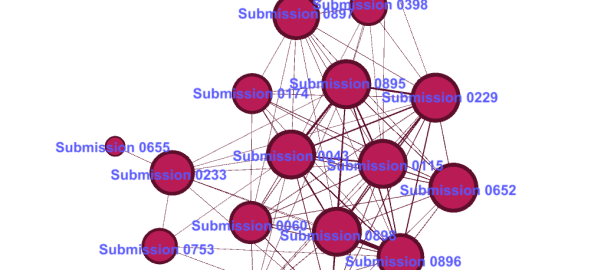In the previous post, I explored the use of function words — that is, words without semantic content, like it and the — as a way of fingerprinting documents and identifying sets that are composed largely of the same text. I was inspired to do this when I realised that the dataset that I was exploring — a collection of nearly 900 public submissions to an inquiry by the New South Wales parliament into coal seam gas — contained several sets of documents that were nearly identical. The function-word fingerprinting technique that I used was far from perfect, but it did assist in the process of fishing out these recycled submissions.
That exercise was really a diversion from the objective of analysing the semantic content of these submissions — or in other words, what they are actually talking about. Of course, at a broad level, what the submissions are talking about is obvious, since they are all responses to an inquiry into the environmental, health, economic and social impacts of coal seam gas activities. But each submission (or at least each unique one) is bound to address the terms of reference differently, focussing on particular topics and making different arguments for or against coal seam gas development. Without reading and making notes about every individual submission, I wanted to know the scope of topics that the submissions discuss. And further to that, I wanted to see how the coverage of topics varied across the submissions.
Why did I want to do this? I’ll admit that my primary motivation was not to learn about the submissions themselves, but to try my hand at some analytical techniques. Ultimately, I want to use computational methods like text analytics to answer real questions about the social world. But first I need some practice at actually doing some text analytics, and some exposure to the mechanics of how it works. That, more than anything else, was the purpose of the exercise documented below. Continue reading Mapping concepts, comparing texts
